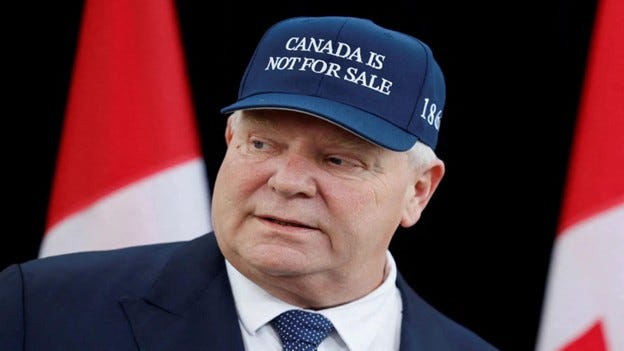Ever since Trump announced that he would impose a 25% tariff on imports from Canada until the country clamped down on drugs, particularly fentanyl, and migrants crossing the border, the press, politicians, and twitterati seem to have lost their minds. On one hand it’s understandable, Canada and the US share the longest undefended border in the world, a testament to the long, peaceful relations between the two nations, and to many Canadians the threat feels like a betrayal. On the other hand, the world doesn’t care about our feelings and it’s best to remember what Henry Kissinger said:
“America has no permanent friends or enemies, only interests”
Canada needs a plan.
Watching the politicians, pundits, and yes the twitterati discuss Trumps impending tariffs brings this quote to mind:
Five percent of the people think; ten percent of the people think they think; and the other eighty-five percent would rather die than think.
-- Thomas A. Edison
You’ll forgive me then if I don’t start with “it goes without saying” but instead make it clear that Canada does not need a plan, it needs an intelligent plan. “Intelligent” must be added to my statement because too many people presenting ideas seem to be demonstrating living proof of the politician's syllogism, also known as politician's fallacy:
We must do something.
This is something.
Therefore, we must do this.
Most of the “plans” I have seen so far can be broken into three camps:
Stand up to Trump
“It’s not fair”
The “Stand up to Trump” approach takes various forms but mostly comes down to bluster and performatives actions.
Isn’t that cute? Victory is at hand! Sadly, given the state of Canada’s military, this picture would be more effective as an argument for increased defense spending than as a response to the tariff threat.
This sentiment is not just an internet phenomenon. "Canada is Not for Sale" hats have gone viral in response to the tariffs and Trump’s suggestion that Canada become the 51st state. Tens of thousands have been sold likely due to Ontario Premier Doug Ford sporting one.
There’s no harm in this message or one stating that “we’re all in it together,” in fact it’s nice to see this solidarity. The problem is that while it may grow followers, sell hats, and let politicians appear strong, it does nothing to stop the tariffs. It’s also simply not true. We’re not all in it together. Some industries, some companies, and some people will be hit harder than others.
If we’re going to be united, perhaps we should unite in demanding that the Canadian government tackle fentanyl smuggling and illegal immigration. You know, actions that might prevent the tariffs and what the government should be doing anyway.
The next approach, the “it’s not fair” “strategy,” combines venting with attempts at persuasion. This approach is peak Trudeau, all words, no action. It’s founded on the belief that Trump doesn’t really understand what he’s doing and if he’s just presented with the facts this will all just go away. We can see it in Trudeau’s recent statement that “less than 1% of fentanyl and illegal immigrants that enter the United States come from Canada” and that if the US doesn’t buy its resources from the Canada it would be forced to get “more resources from Russia, China, or Venezuela.” He then added that the government will be on the lookout for “unfair tariffs.”
People who think this approach will work seem to forget that Trump has called himself a “Tariff Man” and it’s the way he negotiates. His intent is to make the target hurt until he gets what he wants. He demonstrated this most recently when he used the threat of 50% tariffs against Columbia when the country refused to take flights of deported immigrants from the US. There’s some debate as to whether or not the threat worked but that’s beside the point. The point is that when Trump wants something he uses tariffs. The question Canadian politicians should be asking is “does Trump want something reasonable?” If all he wants is for Canada’s government to do something it should have been doing in the first place then the answer is “yes.”
The final “strategy” is the tit-for-tat approach; matching tariffs dollar-for-dollar. Of the three approaches we’ve seen so far this is by far the worst. Not only will it fail but it would likely result in the second worst recession in the last 50 years.
Put simply, anyone who thinks Canada can win a trade war with the US by matching tariffs tit for tat doesn’t understand the relative sizes of the economies.
Sleeping with an Elephant
Prime Minister Pierre Trudeau once remarked that living next to the US “is in some ways like sleeping with an elephant. No matter how friendly and even-tempered is the beast, if I can call it that, one is affected by every twitch and grunt.” Notice the “friendly” comment? What happens when the elephant stops being friendly?
The Canadian economy is roughly an eleventh the size of America’s and that’s not even the real problem. The real problem is the relative importance of cross border trade to both countries. While it is true that Canada and the US are each other’s largest trading partners and exchange roughly the same amount of goods (exports from Canada to the U.S.: ~$500 billion; exports from the U.S. to Canada: ~$450 billion), the impact of this trade on GDP is vastly different as this table shows:
Put simply, if trade between the two countries was halted, the US would take a 3.8% hit to its GDP while Canada’s GDP would almost be cut in half. Trade with the US is a cornerstone of Canada’s economy and any long-term trade war would be devastating.
Framed in the most generous light, for the tit-for-tat approach to be successful it would need the Americans to fold quickly. This would require the American people to put pressure on Trump or other politicians to end it. This is unlikely as it rests on the assumption that the American’s are much less resistant to economic pain than Canadians.
We are forced to return to what I said earlier: Canada doesn’t need a plan; it needs an intelligent plan.
Pressure Points
I’m pleased to see the beginnings of a third idea; hit back strategically, or in the words of Pierre Poilievre, “We have to be very pinpoint and surgical.”
Poilievre’s strategy would combine diversification efforts, infrastructure investments, and “an emergency ‘bring-it-home’ tax cut” with efforts to eliminate interprovincial trade barriers. Studies have shown that these barriers are equivalent to tariffs as high as 25%. Eliminating them would increase Canada’s GDP by between $50-100 billion and is entirely within the power of the federal and provincial governments. It should be done regardless of what happens with the tariffs. Details around the tax cut are lacking but would be a much better idea than the Liberal/NDP regime suggestion of resurrecting the COVID pandemic style payments which saw inflation rise to over 8.0%
These are good steps but are largely defensive in nature. If Canada is going to bring the tariffs to an end the country needs to be aggressive. America might not feel Canadian tariffs but perhaps a pinpoint and surgical” approach might work.
The best defense is a good offence
Former Speaker of the US House of Representatives Tip O’Neill use to frequently comment that “all politics is local.” Hitting the US with broad-based 25% tariffs is unlikely to affect Trump but that doesn’t mean he doesn’t have pressure points. Trump has an agenda but he’s the president, not a dictator which means much of what he wishes to accomplish requires the support of Congress. Congressional votes can be very close. A perfect example is the recent confirmation of Pete Hegseth as the Secretary of Defense. Vice President J.D. Vance cast the deciding vote to confirm Hegseth because Republican Senators Mitch McConnell, Lisa Murkowski, and Susan Collins opposed him. What other items on Trumps agenda will be this close?
Currently the Republicans hold a 3-seat majority in the Senate and an 8-seat majority in the House. A Canadian tariff strategy should be based on putting pressure on republican senators and congressmen in states which are the most economically dependent on trade with Canada. If 3 senators or 5 representatives can be convinced that a trade war with Canada is a danger to their reelection bids, they might put pressure on Trump to stop the tariffs.
Where to squeeze
Political maps of the Senate and House of Representatives show a lot of red these days.
US Senate
By DimensionalFusion - Own work 119th United States Congress, CC BY-SA 4.0, https://commons.wikimedia.org/w/index.php?curid=155056942
The economic details, however, are much more revealing.
A quick look at this chart shows trade with Canada is a significant portion of many states’ GDP. Michigan for example owes 22% of it’s GDP to trade with Canada. A trade war focused entirely on making it feel the pain has the potential of turning 7 republican senators into Canadian allies. Would these representatives be willing to risk their reelection bids on a long trade war that undermined Michigan’s economy and threatened people’s livelihoods? Or could they be convinced to tell Trump that they will oppose Trumps agenda unless the trade war is called off? Hard to say. Still, I’d be a little less “surgical” and broaden the focus to states in which trade with Canada is 10% of GDP or higher. Economic pain back home might make the 5 republican senators and 10 republican representatives in these states pressure the Trump administration to rethink the trade war. Politicians might love Trump’s agenda, but I guarantee they love their jobs more. Tariffs focused on agriculture, automotive parts, dairy, and energy might be the best approach. These would also expose the other states on the list to the pain of a trade war and just might convince another 5 senators and 27 representatives that a trade war with Canada isn’t worth it.
Conclusion
We’ll know on February 1st if Trump is serious about the tariffs. It’s a widely held belief that nobody wins a trade war so let’s hope that this is just Trump blustering and trolling as he’s wont to do. Hope, however, is not a plan and bluster, pleading, and matching the tariffs tit-for-tat aren’t much better. Canada needs an intelligent plan. Even with one though Canada can’t hope to beat the US. It’s just too big. We can’t beat the US, but we might be able to beat Trump. The trick will be to find something that's personally important to him and... squeeze.













Funny seeing the very people who have spent the last decade attacking our national symbols and institutions now pretend to be patriots. And those who claimed to be so patriotic begging to surrender our national sovereignty.
It shows the Liberal Party views Canada as their own personal fiefdom, to be treated as a banana republic.
It shows so called 'patriots' don't have much foresight or hindsight. 1. Trump won't be president forever. 2. Once you join the Union you cannot leave. They are also lacking in backbone. The Baltic states endured nearly a century of Soviet occuption but they never gave up on their independence. People need to think bigger picture.
How about just stopping the fentanyl and illegal alien flow? That seems to be the most intelligent strategy where everyone wins.